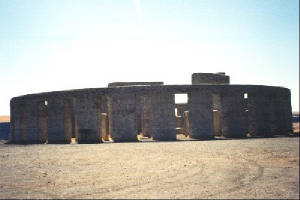|
Tearmunn |
|
Places Stonehenge: Stonehenge is the highly debated monument,
as to who built it and why. Stonehenge was built in 3 phases sterning many years apart. Due to the weight, distance to be
moved, and other factors it would take someone highly skilled in math to figure out just how to do this. Stonehenge is well
known for its astronomical attributes concerning seasons, and solstices, so it would tae someone highly skilled in astronomy
to figure out where to align these big stones. A highly sacred place needed to be situated in a relatively safe place but
still accessible to various areas. Multitudes of stone circles are located throughout the druid nations. Stones are thought
to be a grounding agent. Circles were symbolic to the druids. Who lived in the area or its proximity to access such a monument.
All factors and attributes point to the druid people and the nations. Today, through the co-operation of several British Druidic
groups, it is open to the general public on summer solstice morning, and a festival takes place there at that time every year.
Callanish: A very interesting monument stands in
The outer Hebrides of Scotland on the Island of Lewis. The stones are not topped with capstones as they are with stonehenge
but form an interesting shape. The stones form an irregular Celtic Cross, with a large ring of 13 stones surrounding a large
central stone. Four lines of stones extending in a cross shape from the center. The east and west lines have four stones each,
the north line forms an avenue of two parallel lines one with eight and one with ten stones. The south line is formed by six
smaller stones. The main axis is aligned to the midsummer solstice. Other astronomical alignments include the annual rising
places of bright stars Altair and Capella. Newgrange: Newgrange also goes by Cashel Aengus and Brugh Na Boinne. It is a "passage
grave" or "passage mound". New Grange is the world's largest passage mound of its kind, and among the oldest, being made around
3,500 BC. It is a large circular man-made mound of earth surrounded by a ring of kerbstones. A single passage opens from the
south-east face that leads into the mound to a central chamber. The passage is angled so carefully that direct sunlight can
enter as far as the central chamber, some 80 feet inside the monument, only at sunrise on midwinter morning. Close to Newgrange
are several other passage mounds. Knowth, has two passages aligned to sunrise and sunset on the equinoxes. The Loughcrew Complex,
located in a different part of Ireland, and Maes Howe in Scotland also admit sunlight only on Midwinter morning. Glastonbury: Some folkloric traditions and mythographic
examinations suggest that Glastonbury Tor is the mythic Isle of Avalon. It is the reputed burial place of King Arthur. A certain
thorn tree is said to be the descendant of the staff of Joseph of Arimathea, an associate of Christ, which was changed into
a thorn tree when he set it there, when he brought the Holy Grail to Britain. Avalon means "Isle of Apples", and being that
the apple symbolizes manipulation, it would certainy mean that Avalon could be manipulated as to its location, or as to whether
or not it could be seen by mortal eyes. Some archaeologists believe that, if one accounts for centuries of erosion, the sides
of the Tor are terraced into the shape of a Cretan Maze pattern. The Hill of Tara: The Hill of Temhair (Tara), is
located in Meath, and was the seat of Irish kings. There is a stone that stands on it which is thought to be the Lia Fail
or Stone of Destiny. The stone would cry out or scream if a worthy king stood upon it. There is also a small passage mound,
which admits sunlight into the center chamber only on sunrise of Samhain and Imbolc.
Other Places America's Stonehenge is one of the largest and possibly
oldest megalithic (stone-constructed) sites in North America. Like Stonehenge in England, America's Stonehenge was built by
ancient people well versed in astronomy and stone construction. It has been determined that the site is an accurate astronomically
aligned calendar. It was and still can be used to determine specific solar and lunar events of the year. Located in Salem, New Hampshire Maryhill State Park is a 99-acre camping park with 4,700 feet of waterfront on the Columbia River in Klickitat County. The area is significant
for its natural beauty, its access to the surrounding natural wonders and its cultural history. A full-scale model of Stonehenge
stands near the park. Located 12 miles south of Goldendale, Wash.
|
||
|
|
